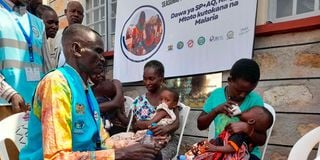How community health promoters are helping save lives

Joshua Ebei, a Community Health Promoter (CPH), administering sulfadoxine-pyrimethamine + amodiaquine doses to children in Kanam Kemer, Turkana Central.The CPH programme was launched last year.
What you need to know:
- 1.9 million Kenyans have been screened for diabetes, while 1.4 million have been checked for hypertension.
- The move has helped residents from low-household incomes get a much earlier diagnosis, thereby saving lives.
At least 30,000 Kenyans with high blood sugar and 64,000 with blood pressure have in the last one year been recommended for facility-based healthcare by community health promoters (CHPs), the Health ministry says.
The latest data by the State Department for Public Health and Professional Standards at the Ministry of Health further shows that over 1.9 million Kenyans have been screened for diabetes, while 1.4 million have been checked for hypertension. The move has helped residents from low-household incomes get a much earlier diagnosis, thereby saving lives.
According to Public Health Principal Secretary Mary Muthoni, the government’s manifesto for Afya Bora Mashinani, dedicated to better bhealth at the grassroots, is firmly rooted in four essential pillars. Firstly, it focuses on the digital transformation of healthcare delivery, streamlining access for all Kenyans, regardless of their location.
“Secondly, it commits to robustly funding the health sector, ensuring ample resources for delivering top-notch healthcare. Thirdly, there is a strong emphasis on expanding the healthcare workforce, bolstering the numbers of doctors, nurses and other professionals to ensure comprehensive coverage,” she told Healthy Nation.
“The overarching goal is to achieve Universal Health Coverage by 2027 by using a more integrative, preventive and promotive service and establishing Multi-Disciplinary Teams (MDTs), which is a primary healthcare approach as envisioned in the Afya Bora Mashinani Plan, elevate the healthcare quality nationwide, and alleviate the financial burden on Kenyans when seeking medical care.”
The CPH programme was launched last year. “The government started on UHC from the recruitment and training of 100,000 CHPs in collaboration with the 47 counties to support the 9,100 community health units (CHUs), collaboration in the formation of the recommended 315 primary care networks and conducting facility census to assess the country’s preparedness for UHC.”
She explained that the State Department of Public Health and Professional Standards has so far conducted a comprehensive health facility assessment in over 14,375 public, faith-based and private health facilities.
It has also undertaken key activities, including cholera and polio vaccination following the recent outbreaks, screening for diseases and comprehensive health education campaigns.
“These efforts are designed to empower Kenyans to make informed decisions about their health, and adopt healthier lifestyles, thereby reducing the burden of preventable diseases,” PS Muthoni told Healthy Nation.
She highlighted that a well-trained and motivated healthcare workforce is essential to delivering quality healthcare services.
“We are working to ensure adequate healthcare professionals and support staff to meet the healthcare needs of the population. Key to these include posting of a total of 4,129 interns: medical officers 325, pharmacists 469, dental officers 25, clinical officers(BSc) 506, clinical officers (Diploma) 1,930, and nurses (degree) 874.”
The PS noted that the State Department has also coordinated orientation and sensitisation of Cuban-trained family physicians from 47 counties, has ensured that the Kenya Medical Practitioners and Dentists Council has registered 185 medical and dental practitioners, 32 community oral health officers, 44 medical and dental practitioners on temporary registration and licensing of 36 medical and dental interns.
“The Kenya Health Professions Oversight Authority inspected 13,996 health facilities for compliance with standards in service delivery, while 17 level five hospitals were assessed for emergency care preparedness.
“We have also flagged 248 PCN master trainers of trainers to propel the expansion of primary care networks (PCN) across the counties, and foster a more resilient healthcare system,” PS Muthoni observed, adding that they have fully digitised the community health information system in all counties.
She further noted that the government has developed an electronic Community Health Information System and scaled it up to seven counties so far.
Currently, there is at least one PCN established in 41 out of the 47 counties (87 per cent), 34 PCNs are in the process of being established in 12 counties, while 16 counties have fully established PCNs.
“They include Embu, Garissa, Kajiado, Kakamega, Kericho, Lamu, Laikipia, Makueni, Murang’a, Nakuru, Nyandarua, Nyeri, Tharaka Nithi, Trans Nzoia, Uasin Gishu and Vihiga,” she said, highlighting that functional PCNs have shown great success in quality PHC service provision, more outreaches, household service provision, increased diseases screening and client identification with silent unidentified diseases, better referral and health worker’s coordination.
The PS told Healthy Nation that the Health ministry has also been working to reduce malaria incidence from 122 cases per 1,000 people in 2015 to 105 cases per 1,000 people in 2023.
“Mass LLIN distribution has been conducted to protect people living in malaria risk areas. Currently, the ministry is distributing 15.3 million nets in 22 high-burden counties,” she said, adding that digitisation of mass net distribution was done, and four counties have already distributed the LLINs.
“The net coverage per county was 96 per cent for Homa Bay, 94 per cent for Kisii, 92 per cent for Nyamira and Kisumu.”





